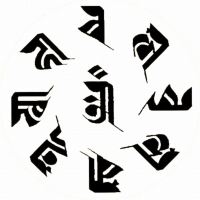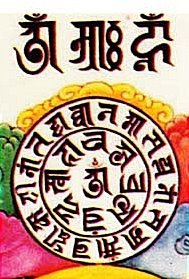 A couple of days ago I noticed a mystery mantra on Omniglot's Puzzles Page. I couldn't see well enough to read so wrote and asked Mitchell who'd posted it to send a better quality image. He sent me the image on the left and things became more clear.
A couple of days ago I noticed a mystery mantra on Omniglot's Puzzles Page. I couldn't see well enough to read so wrote and asked Mitchell who'd posted it to send a better quality image. He sent me the image on the left and things became more clear.The script is obviously Lantsa. I know some Lantsa and there are one or two Lantsa resources on the web (see the scripts page) but I'm not very confident in it yet.
The centre syllable is obviously oṃ. From 12 o'clock I read ca le cu le co nde svā hā.
So the mantra is: oṃ cale cuale conde svāhā.
However this is not a mantra I am familiar with, nor can I find it in any of my usual sources. If you know this mantra please let me know.
Update: 18-9-08 and 3-11-08

Thanks to Fuxi who wrote in to suggest that this mantra may be related to Zhunti. If you look at Mediation Expert you can see the same diagram on a page of the sadhana instruction. In Sanskrit the name is Cundī, meaning "pure" and she is a feminine form of Avalokiteśvara, or perhaps a form of Uṣas or Mārīcī. In the Mahācundi Dhāraṇī there is a mantra: namo saptanam samyaksambuddha kotinam tadyatha: oṃ cale cule cundi svaha. The mantra above could be a form of this.
If you look at the image on the left, which is a close-up of a Cundi image, you can see some Sinified Lantsa script.
Across the top in larger letters is: oṃ āḥ hūṃ
Around the outer circle of the image reads: namo saptanam samyaksambuddha kotinam tadyatha. It starts just to the right of 12 o'clock.
The centre of the circle matches the image originally sent to Omniglot by Mitchell, with oṃ at the very centre. Ca is distinguished by a point on the loop - so with some hindsight we can see that the character could be ca. On the 3rd character what I took to be an 'r' ligature could be a 'u' diacritic though this usually is more curved and doesn't terminate on the stem. So the mantra above should be read:
oṃ cale cule cunde svāhā.

Could it be Zhunti buddha mantra? Google "Zhunti" image.
ReplyDeleteZhunti buddha is very popular in Chinese Zen sect.
Note that this mantra: namo saptanam samyaksambuddha kotinam tadyatha: om, cale, cule, cundi svaha appears in the Kāraṇḍavyūha Sūtra where is it delivered by seventy-seven (saptanam) Perfectly enlightened Buddha familes (samyaksambuddha kotinam) in response to the the Bodhisattva Sarvanīvaraṇaviṣkambhin announcing that he has achieved his aim to obtain the mantra "oṃ maṇipadme hūṃ".
ReplyDelete- in Studholm, A. The Origins of Oṃ Maṇipadme Hūṃ : a study of the Kāraṇḍavyūha Sūtra. Albany : SUNY Press, 2002. p.149.
It looks like you aren't the first person to have this problem!
ReplyDeleteIn "Liberation in the Palm of Your Hand" Pabonka Rinpoche, Wisdom Publications, 1997, P275, Pabonka Rinpoche recounts that:
Another person mistook "om vale vale vunde svaha" for the mantra of the goddess Chunda. The v's are wrong: they should be ch's.
But is was OK. PB says that as long as you have faith, even wrong mantras work:
He recited this a number of times and so during a famine was able to cook and eat rocks.
Roger Wright
Roger_Wright
[at]
attglobal.net
Hi Roger,
ReplyDeleteThanks for your comments. Interesting to see that it is the faith rather than the mantra that brings benefits - this corresponds to my own thinking. But now I wonder why we use mantras at all. Why not just say "ricebubbles", or "God help me"?
JR